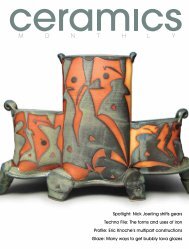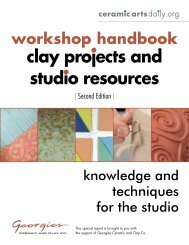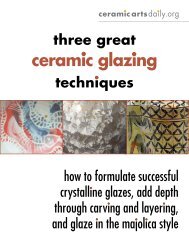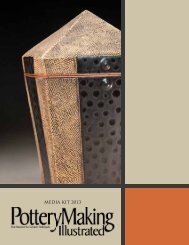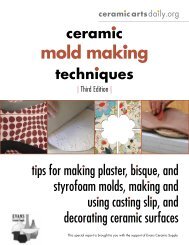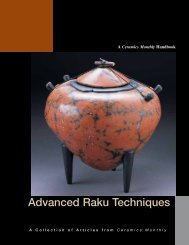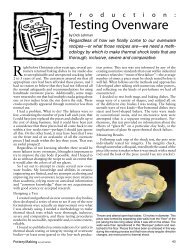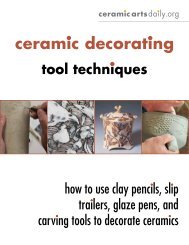Buying Porcelain - Ceramic Arts Daily
Buying Porcelain - Ceramic Arts Daily
Buying Porcelain - Ceramic Arts Daily
Create successful ePaper yourself
Turn your PDF publications into a flip-book with our unique Google optimized e-Paper software.
tiPs for getting starteD<br />
Studio Setup and<br />
Work Methods<br />
Do you have the right studio setup for<br />
porcelain and are you able to adjust<br />
your current workplace with ease?<br />
Requirements:<br />
• Work with precision and in a<br />
clean studio<br />
• If you work with other clay bodies<br />
that might contaminate porcelain,<br />
or are there other potters working<br />
with you that do so, you need a<br />
separate porcelain work station/<br />
reclaim/ wedging area.<br />
• If you work mostly with an extruder<br />
with a steel chamber and plunger,<br />
you’ll need to replace it with a<br />
stainless steel or aluminum one to<br />
avoid possible rust contamination.<br />
• If you primarily handbuild but use<br />
different clays, be sure your tools<br />
are clean, and any steel tools are<br />
rust-free before beginning work<br />
with porcelain. Reserve a piece of<br />
canvas or a ware board for porcelain<br />
work only.<br />
Skill Level Considerations<br />
It’s important to know your own abilities<br />
and skill level. If you’re a beginner<br />
who wants to throw 20 inch tall<br />
pots, you’ll have a lot of difficulty<br />
achieving your goals and there will<br />
be a whole lot of frustration, time and<br />
money wasted before you can reach<br />
them. In such a case, it’s better to use<br />
a white stoneware clay in the beginning<br />
and gradually work your way<br />
first through a semi-porcelain body<br />
and then once you’ve masterd that,<br />
eventually to pure porcelain as your<br />
skills improve.<br />
If you choose to work with pure white, translucent clay,<br />
you can always throw thicker and trim thin afterward. If<br />
you need an all translucent, white and a non-warping clay<br />
body, it might cost a little more, but your ceramic supplier<br />
can recommend the right clay body for your purposes.<br />
Amazingly, you will even find that some of the semiporcelaneous<br />
clay bodies meet all the characteristics of<br />
porcelain and have the added green strength that is often<br />
missing in true porcelains. Add these qualities to the fact<br />
that you can save energy because many of the commercial<br />
clays are formulated for firing at cone 6 electric, and<br />
there are very few restrictions left that would limit you<br />
from working with this material.<br />
Test several clay bodies for their ability to throw, to trim<br />
and to keep their shape even when stretched to their limits.<br />
Also test them to see how they stand up to adjustments<br />
and attachments, then fired them to the proper cone in an<br />
electric kiln. I checked them to see if shrinkage can cause<br />
problems. Compare the tests for shrinkage, color and<br />
translucency before deciding on one over another.<br />
transition carefully<br />
It’s always best to start by buying one bag of clay and<br />
testing it thoroughly. Then, even when you think you’re<br />
satisfied with your choice, make the transition to your new<br />
style and clay body slowly and carefully. <strong>Porcelain</strong> is expensive<br />
but if you take a conservative approach, and do<br />
enough testing to make an informed decision, it will pay<br />
to make an investment in a large batch of clay.<br />
a final WorD<br />
I’ve seen porcelain clay bodies improve from one batch<br />
to another. Clay companies are constantly doing research<br />
to improve their clays. If you consult your clay<br />
company, they’ll know what to recommend to you only if<br />
you understand your own needs and what you want. To<br />
us, as potters, that’s good news, because it means that if<br />
we admire a specific clay body today, but it’s not working<br />
for our circumstances, it’s worth discussing that with<br />
our clay producer and retesting a body again to see if<br />
it has changed. Maybe your skills improve, perhaps the<br />
clay composition improves, or maybe you and that specific<br />
clay body simply get in sync with each other.<br />
Read the literature available online, then talk to a sales<br />
representative and they’ll be able to recommend the right<br />
clay body for your needs.<br />
Thanks to T Robert at Laguna Clay and Carla Flati of<br />
Standard <strong>Ceramic</strong>s.<br />
©2010 <strong>Ceramic</strong> Publications Company



